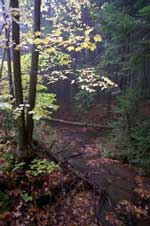About 40 years ago, a young Dartmouth biology professor named Herb Bormann took a tomato plant, gently pulled its roots apart into two bunches, and planted it in two pots, one clump of roots in each pot. He watered both pots until the plant got established. Then he watered only one pot. The tomato did fine.

Photo by David Parsons, NREL/PIX.
Then he repeated the experiment many times with the addition of a second plant rooted only in the unwatered pot. Some of those second plants also did fine. Others wilted, but more slowly than did control plants in unwatered pots without a “donor.” Later experiments showed that one plant could pass not only water but also radioisotopes to another.
Bormann began digging around in a white pine forest near the Dartmouth campus and injecting tree roots with dyes, herbicides, and radioactive tracers. He found that the trees not only passed these markers around, but that their roots had actually grown together into complex networks of “grafts.” Through the grafts, large trees tended to pass nutrients to smaller, weaker trees. They even kept alive stumps, which went on growing, sometimes for decades, though they never regenerated branches or leaves.
Bormann later wrote: “This research indicated that the role of … competition in determining which trees in a … stand will survive was overrated. In many stands, many trees are linked into organic unions. … Participants in the union have lost at least part of their individuality and are subject to the … influence of their grafted companions.”
Even when Bormann did this research, the knowledge that trees interconnect below ground was not new. One of his teachers had told him how oak trees transmit diseases through root grafts. As long ago as the 1920s, root grafts had been observed in white pine, Douglas fir, and balsam fir forests, as had the phenomenon of “living stumps.”
By 1966, Bormann and his colleague B.F. Graham could write a review article listing more than 180 scientific articles on the passage of materials between the roots of at least 150 species of trees, including oak, maple, linden, spruce, ash, larch, birch, fir, and pine. There are root grafts between different species — maple and birch, birch and elm, and sandalwood and the tropical tree Eugenia. (The grafts reportedly give the Eugenia the scent of sandalwood.)
Sometimes the transfers occur through root grafts. Sometimes they just pass through the soil, as with Bormann’s tomatoes. Sometimes there are inter-tree carriers, mats of cooperating fungi called mycorrhizae (pronounced mike-o-rye-zee), which intermingle with tree roots, subsist on sugars produced by the tree leaves, and in return mobilize nutrients from the soil. The most common traffic is in sugars, growth hormones, herbicides, and disease organisms. Less common are transfers of water (in large amounts) or mineral nutrients.
This underground tree trade is apparently well known to biologists, but they haven’t made a big deal of it. I have taken many biology courses, but I was surprised when forest ecologist Scot Zens mentioned root grafts in a conversation a few months ago, as if I knew about them. I didn’t. The very idea stopped me in my tracks. It changed my whole view of what a forest is. What? The roots grow together? The trees pass stuff around? What does that mean?
What does it mean to forest management, to selective harvesting, to clear-cutting? What does it mean when acid rain falls, when drought comes, when herbicide is sprayed, when we try to fight off tree diseases? What does it mean to our cultural notion that the world runs on competition, not cooperation? Are we biased toward seeing only collections of individuals rather than interconnected systems? Have we literally been failing to see the forest for the trees?
The scientists who blazed research trails on tree transfers, instead of following the well-trampled professional highway investigating competition, have written mainly about what root grafts mean for forestry. Cutting a tree but leaving its stump may be no help in preventing the spread of disease. Trying to kill selected trees by injecting herbicide could spread the poison to non-targeted trees. Girdling trees with strong root grafts may not kill them, at least not below the girdle. Interlocked trees are probably more resistant to wind throw but less resistant to disease. Selective cutting may produce unexpected results — you may remove not a competitor but a partner.
I would love to draw deeper lessons than those practical ones. I have a bias opposite to the one my science professors so assiduously tried to instill in me. I prefer to believe in cooperation as a working principle, not competition. I like to think about complex interacting systems. I have an instinctive (some would say irrational) notion that the forest knows and weeps when a single tree falls. I love the notion of secret traffic among trees.
Like my scientific brethren and sistren on the opposite side of the bias, I am not blind to the social implications of lessons purportedly drawn from nature. Aha! I can say. Big trees support small trees. Trees stand together, they don’t struggle against each other. When we take one away, we send waves through an interconnected community. If this is true for trees, might it not work for people?
Which is, of course, as oversimplified a picture as is the notion that the forest is nothing but the sum of its trees. There is plenty of competition in a forest. Inter-tree networks spread disease and poisons as well as nutrients and hormones. No one understands the reason — if there is one — why any tree shares anything with another. Nature is too complex to ratify our simple worldviews. Whatever we understand about the interconnections among trees, there is probably much more that we don’t understand.
If there’s any unbiased lesson to be drawn from the community of trees, that’s probably it.

